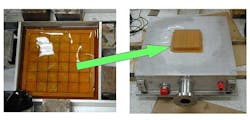Navy chooses adhesive from Alfa International for underwater transducers and hydrophones
Officials of the Naval Undersea Warfare Center (NUWC) Newport in Middletown, R.I., are working together with Alfa to commercialize the company's NUWC XP-1 high-performance polyurethane to protect marine acoustic and optical equipment.
Almost all acoustic projectors and hydrophones are encapsulated in polymeric materials to protect them from water while allowing acoustic energy to pass without significant reflection, loss, or distortion.
To do this these undersea devices need materials for acoustical performance with properties like density and sound speeds close to those of seawater; low mechanical loss tangent; medium to high shear loss tangent; low shear storage modulus; Poisson's ratio near 0.50; and no major polymeric transitions in or near the frequency and temperature ranges of interest.
Related: Master Bond introduces two-part epoxy adhesive for aerospace and electronics uses
Alfa's NUWC XP-1 offers these properties, officials say. The adhesive uses a toluene diisocyanate/polyether polyol base (molecular weight about 1500) and dimethylthiotoluenediamine as the cross-linking and curing agent.
The two-part polyurethane exhibits good hydrolytic stability and exceptional acoustic properties while also being optically clear, NUWC officials say. Unlike other encapsulates, NUWC XP-1 can be cured at room or elevated temperatures in less than 24 hours.
“Navy chemists and material scientists first developed the polyurethane known as NUWC XP-1 in the 1990s,” says NUWC commander Capt. Howard Goldman. “NUWC Newport has continued investment to optimize the formulation for protection of equipment such as sonar transducers from damage caused by water seepage in the undersea environment."
Alfa International will manufacture and offer the product for sale to government and commercial customers. “NUWC XP-1 fits nicely into our existing portfolio of products for the electronics, aerospace, and telecommunications industries,” says Rajab Aboubakr, president of Alfa International.
Related: Electronics adhesive epoxy that resists extremes in temperature introduced by Epoxies Etc.
NUWC XP-1 cures overnight at room temperature to 75 Shore A hardness. Its sound speed is very close to that of seawater at room temperature, and at 25/spl deg/C, its acoustic impedance is 1.71/spl times/10/sup 6/ metric Rayls.
NUWC XP-1 exhibits a sub-ambient glass transition temperature (-31/spl deg/C) and its dynamic mechanical properties are almost ideal for underwater transducer/hydrophone encapsulants, experts say.
A distinct benefit to the industry is that the chemical formula of NUWC XP-1 is controlled by the U.S. Navy. The material is made from basic raw materials, thus its future availability is more assured than many other commercial products.
For more information contact Alfa International Corp. online at www.alfaadhesives.com, or the Naval Undersea Warfare Center Newport at www.navsea.navy.mil/Home/WarfareCenters/NUWCNewport.
